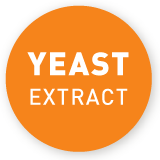Glutamate – for some consumers a controversial word. But what few people know: Glutamate is not the same as the flavour enhancer monosodium glutamate. Glutamate is an amino acid naturally found in various foods and perceived as a spicy flavour. Expert Prof. Dr. rer. nat. Ursula Bordewick-Dell of the Oecotrophology Department at the Münster University of Applied Sciences illustrates the background and explains why high glutamate content in ready meals can even be a sign of particularly good quality.
Professor Bordewick-Dell, what exactly is the difference between glutamate and monosodium glutamate?
Monosodium glutamate is an isolated pure substance: the pure salt in glutamic acid is not naturally found in foods in this form. Monosodium glutamate further has no taste of its own but can only enhance other flavours – so it’s a flavour enhancer. Natural glutamate on the other hand is an amino acid found in numerous high-protein foods.
In which foodstuffs does glutamate occur?
Glutamate is a completely natural building block of proteins. So it by no means only occurs in heavily processed foods, it is found in all protein-rich food sources – for instance in meat, fish and even in pulses. Moreover, glutamate is formed naturally through the enzymatic ripening process in foodstuffs and sometimes in appreciable amounts, for instance in tomatoes and Parmesan. Glutamate is therefore a key component in our daily diet – however many consumers are unaware that it occurs naturally.
In the last couple of months, yeast extract was often associated with glutamate by the media – is it correct that yeast extract contains glutamate?
Yes, that’s true – but this again is natural glutamate, not the isolated flavour enhancer monosodium glutamate. These two are often confused. Yeast extract is extracted from yeast and naturally contains glutamic acid aside from other amino acids, vitamins and minerals. So it’s not an isolated pure substance, but an ingredient – just like spices – with its own aromatic flavour.
What does the glutamate content say about the quality of ready meals?
Here too we shouldn’t confuse naturally occurring glutamate with the additive monosodium glutamate! A high natural glutamate content in processed foodstuffs may even be indicative of high quality – if, for instance, a frozen lasagne is prepared using a high proportion of meat, particularly ripe tomatoes and real Parmesan, it too will have a particularly high glutamate level. This occurs due to the matured ingredients which are naturally protein-rich.
Are there other traditional dishes which contain particularly high levels of glutamate?
Yes; in addition to the lasagne mentioned, Spaghetti Bolognese for instance has a naturally high glutamate level – here too we have a combination of meat, tomatoes and Parmesan. Typical Italian dishes with these ingredients generally have a high glutamate level. Many other traditional meals which have a high proportion of meat also contain appreciable amounts of natural glutamate. This is all the more so the case when meat and pulses are combined, for instance a stew with peas.
What effect does this natural glutamate in meals have on our perception of taste?
The glutamate content of meals provides an aromatic taste perception, known as ‘umami’. When foods containing glutamate are consumed this flavour is perceived as being particularly delicious and pleasurable – which explains why the above-mentioned glutamate-rich traditional meals remain so popular today. Our body ensures an adequate protein supply through its preference for the flavour “umami”, since the foods in question are always high in protein.
More information about EURASYP:
EURASYP is an abbreviation of European Association for Specialty Yeast Products. European manufacturers of specialist yeast products are members of the association. The association is a point of contact for those in the realms of politics, economics, media, trade and the food industry, for any questions on the topic of specialist yeast products. EURASYP members include Bio Springer, DSM, Kerry, Lallemand, Leiber, Ohly and Sensient.
More information available at www.yeastextract.info
| Additional information | Media Contact |
| European Association for Specialty Yeast Products
42 rue de Châteaudun F-75314 PARIS CEDEX 09 Phone: +33 (0) 1 43 53 36 59 E-mail: info@yeast extract.info www.yeast extract.info |
Kohl PR & Partner
Annegret Winzer Schiffbauerdamm 40 10117 Berlin Phone: 030-22 66 79 24 E-mail: a.winzer@kohl-pr.de www.kohl-pr.de |



